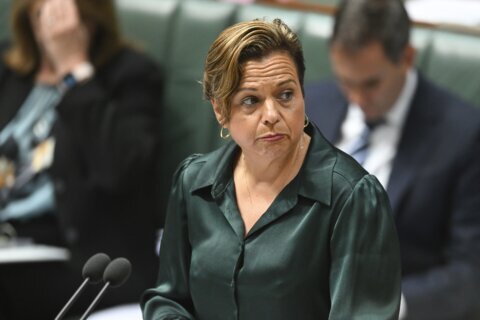CANBERRA, Australia (AP) — Anthony Albanese will become the first Australian prime minister in seven years to visit China in recognition that bilateral relations have improved after crashing to unprecedented depths over trade and security differences that remain largely unresolved.
The 2022 election of Albanese’s center-left government after nine years of conservative rule created an opportunity for a reset. He arrives Saturday on a three-day visit that will take him to Shanghai then Beijing, where he’ll meet with President Xi Jinping.
Xi had two meetings in six months with an Australian prime minister in 2016, but China severed top-level ministerial contacts with Australia after that. Official and unofficial trade sanctions stacked up since 2020 to cost Australian exporters up to 20 billion Australian dollars ($13 billion) a year for commodities including coal, wine, beef, barley and lobsters.
Many say the trade boycott hurt an economically troubled China while Australia showed no signs of bending to Beijing’s coercion.
“It’s in Australia’s interest to have good relations with China,” Albanese told reporters in October, when he announced the trip.
But Albanese’s government is also deepening security ties with the United States, notably with the AUKUS agreement involving Britain that will provide Australia with a fleet of submarines powered by U.S. nuclear technology.
No significant announcements are expected during Albanese’s largely symbolic visit, which comes close to the 50th anniversary of the first trip by an Australian prime minister to the People’s Republic of China.
Albanese is expected to attend the Sunday opening of the China International Import Expo in Shanghai, and has scheduled meetings in Beijing with Xi on Monday and Premier Li Qiang on Tuesday.
The Chinese leaders’ discussions with Albanese would cover bilateral relations and international and regional issues, Chinese Foreign Ministry spokesperson Wang Wenbin told reporters Friday. “A healthy and stable relationship is in the fundamental interests of the two countries and peoples, and is conducive to regional and world peace and stability,” Wang said.
He said China would use the visit to work with Australia to expand cooperation “in the spirit of mutual respect, mutual benefit and seeking common ground while reserving differences.”
Shi Yinhong, an international relations professor at Beijing’s Renmin University of China, said the Chinese wanted to improve trade relations after a “largely ineffective de facto boycott.”
But Shi noted that not all the trade barriers had been lifted, although Australia is confident that steep tariffs on wine will be removed within months. The wine trade was worth AU$1.2 billion ($771 million) a year.
Australia’s first serious mistakes in Chinese eyes came in 2018 with moves that were seen as emphasizing China as a security threat.
The Australian Parliament passed national security legislation that banned covert foreign interference in domestic politics and made industrial espionage for a foreign power a crime. Two months later, the government banned Chinese-owned telecommunications giant Huawei from rolling out its 5G network in Australia due to unspecified security concerns.
The Chinese trade barriers followed the Australian government’s demands for an independent inquiry into the origins of COVID-19 and China’s responses to the pandemic. China has accused Australia, the U.S. and others of politicizing the issue.
Albanese maintains he has made no concessions to China to achieve more stable relations, citing the October release of Australian journalist Cheng Lei, who was detained in China for three years in a case concerning state secrets.
But just before his planned trip was announced, Albanese’s government said it would not cancel a Chinese company’s 99-year lease on Darwin Port despite U.S. concerns that foreign control could be used to spy on its military forces. Albanese had criticized the lease since it was signed in 2015, and some security analysts interpreted the decision to let Shandong Landbridge Group keep the lease as a concession to China ahead of his visit.
Australia is trying to find the right balance between security concerns and the need to have a peaceful region and productive economic ties with China, said Jude Blanchette, a China expert at the Center for Strategic and International Studies in Washington.
Blanchette said the growing talk of “de-risking” in Australia, or not depending too heavily on one country economically, is likely to be a concern for China in the talks.
Australia’s efforts to diversify trade away from China, its largest trading partner, have struck obstacles.
Australian Trade Minister Don Farrell announced Monday that negotiations on a free trade deal with the European Union had collapsed despite Europe’s eagerness to reduce its own dependency on China. Still, Farrell expects the cost of what his government euphemistically calls “trade impediments” with China will soon diminish from a peak of AU$20 billion ($13 billion) a year to AU$1 billion ($643 million).
Despite the years of political upheaval between Beijing and Canberra, the value of Australian goods and services exported to China more than doubled, said James Laurenceson, director of the Australia-China Relations Institute at the University of Technology Sydney.
Australian government data valued annual exports for the year to August at AU$194 billion ($125 billion). In 2016, that figure for the same period was AU$96 billion ($71 billion at the time).
Wang Yiwei, a Renmin University international relations professor, said China wanted stable diplomatic relations with Australia to underpin economic relations.
“China still hopes that there will be a proper distinction between security and economy,” Wang said.
___
Associated Press writers Ken Moritsugu in Beijing and Christopher Bodeen in Taipei, Taiwan, contributed to this report.
___
Find more AP Asia-Pacific coverage at https://apnews.com/hub/asia-pacific
Copyright © 2024 The Associated Press. All rights reserved. This material may not be published, broadcast, written or redistributed.







